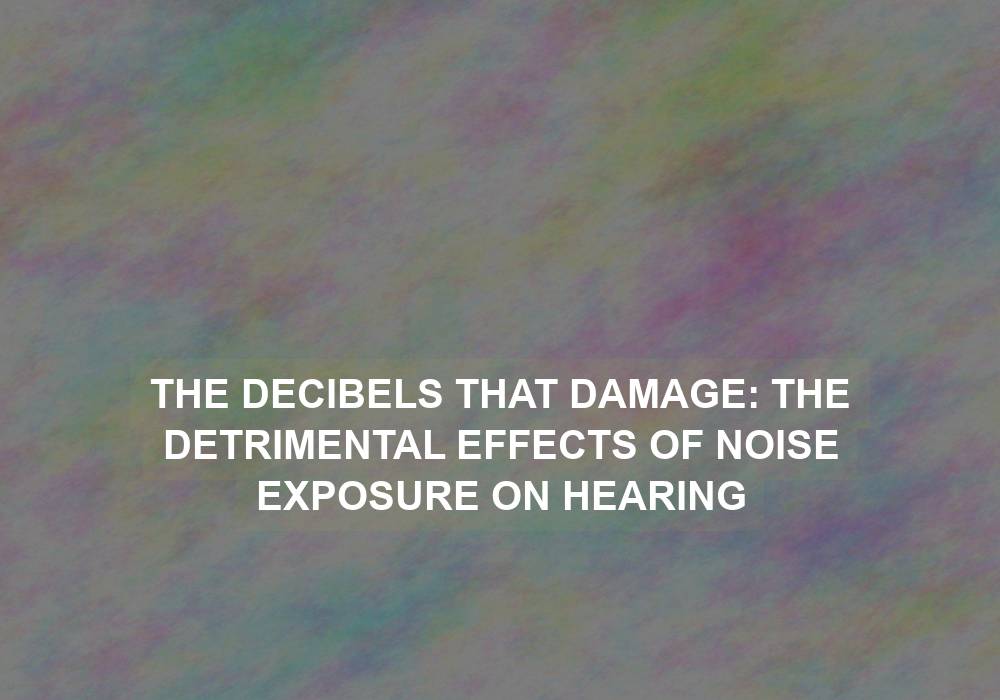Noise pollution is a growing concern in our modern society, and its detrimental effects on our hearing should not be underestimated. Exposure to loud noise can have severe consequences for our auditory system, leading to permanent hearing loss and other related health issues. In this article, we will explore the various aspects of noise-induced hearing loss, its causes, and the preventive measures that can be taken to protect our hearing.
Understanding Noise-Induced Hearing Loss
Noise-induced hearing loss, commonly referred to as NIHL, is a type of hearing impairment caused by prolonged exposure to loud sounds or sudden intense bursts of noise. These sounds, when above safe decibel levels, can damage the delicate structures of the inner ear, including the hair cells responsible for transmitting sound signals to the brain.
Exposure to noise-induced hearing loss can occur in various environments, such as workplaces, recreational activities, and personal audio device usage. It is important to understand the impact of decibel levels and the sources of harmful noise to effectively prevent hearing loss.
The Impact of Decibel Levels
Decibel (dB) is the unit used to measure the intensity or loudness of sound. The higher the decibel level, the louder the sound. Prolonged exposure to sounds above 85 dB can cause irreversible damage to our hearing. To put this into perspective, a normal conversation typically registers at around 60 dB, while a rock concert can reach over 100 dB. It is crucial to limit our exposure to high decibel levels to protect our hearing.
Exposure to sounds above 85 dB for extended periods can lead to temporary or permanent hearing loss. It is important to be aware of the decibel levels in our surroundings and take necessary steps to reduce exposure to loud noises.
Common Sources of Harmful Noise
- Occupational Noise: Many occupations expose workers to high levels of noise on a daily basis. Construction sites, factories, airports, and even music venues can subject individuals to excessive noise levels, putting them at risk of developing NIHL.
Workers in these environments should be provided with proper hearing protection, such as earmuffs or earplugs. Employers should also implement engineering controls, such as soundproofing or noise barriers, to reduce noise levels in the workplace.
- Recreational Activities: Engaging in recreational activities such as attending concerts, sporting events, or using loud machinery for hobbies like woodworking or shooting can also lead to noise-induced hearing loss if proper precautions are not taken.
When attending concerts or sporting events, it is important to consider moving away from the speakers or using earplugs to reduce the intensity of sound reaching our ears. Similarly, when participating in hobbies that involve loud machinery, using hearing protection is essential to prevent damage to our hearing.
- Personal Audio Devices: Listening to music or other audio through headphones or earphones at high volumes for extended periods can be detrimental to our hearing. It is important to maintain a safe volume level and take regular breaks to avoid unnecessary damage.
When using personal audio devices, it is recommended to keep the volume at a moderate level and avoid turning it up to drown out background noise. Noise-canceling headphones can also be used to reduce the need for higher volume levels.
Preventive Measures for Protecting Hearing
-
Use Hearing Protection: When exposed to high noise levels, it is essential to use hearing protection devices such as earmuffs or earplugs. These can significantly reduce the intensity of sound reaching our ears and prevent damage.
-
Limit Exposure: Avoid prolonged exposure to loud noises whenever possible. If you work in a noisy environment, take regular breaks in quieter areas to give your ears a rest. Similarly, when attending concerts or events, consider moving away from the speakers or using earplugs.
-
Be Mindful of Volume: When using personal audio devices, keep the volume at a moderate level and avoid turning it up to drown out background noise. Also, consider using noise-canceling headphones that reduce the need for higher volume levels.
-
Educate Others: Raise awareness about the dangers of noise exposure and the importance of protecting one’s hearing. Encourage others to adopt safe listening habits and promote the use of hearing protection in noisy environments.
By implementing these preventive measures, we can effectively protect our hearing and reduce the risk of noise-induced hearing loss.
Recognizing the Signs of Hearing Loss
It is crucial to be aware of the early signs of hearing loss, as prompt action can help mitigate further damage. Some common signs include:
- Difficulty understanding speech, especially in noisy environments.
- Ringing or buzzing sounds in the ears, known as tinnitus.
- Increased volume requirements for listening to television or conversations.
- Withdrawal from social situations due to communication difficulties.
If you experience any of these symptoms, it is advisable to seek professional help from an audiologist or an ear, nose, and throat specialist. Early intervention and treatment can prevent further deterioration of hearing.
Conclusion
Noise-induced hearing loss is a preventable condition that demands our attention. By understanding the detrimental effects of noise exposure and implementing the necessary preventive measures, we can protect our hearing and safeguard our overall well-being. It is essential to prioritize our auditory health and educate others about the importance of maintaining safe listening practices to enjoy a life filled with the beauty of sound for years to come.
